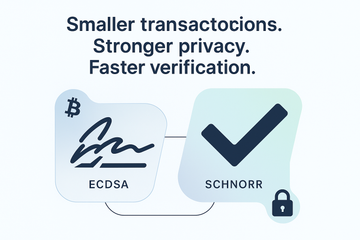So, you’ve heard whispers about Schnorr signatures in crypto circles, right? Maybe you caught the name between conversations about taproot, or while skimming through a Ledger or Trezor wallet update. Honestly, it sounds a bit like a sneeze—or the last name of a no-nonsense German engineer. But tucked inside this oddly named algorithm is a serious upgrade for blockchains. Let’s talk about why Schnorr signatures are catching fire, and what you’re actually getting when your hardware wallet adds support for them.
What’s the Big Deal With Digital Signatures Again?
First things first, a digital signature isn’t just technical bling—it’s the cryptographic heart of how we prove ownership and legitimacy in crypto. No signatures, no decentralized trust. You might already know about ECDSA (Elliptic Curve Digital Signature Algorithm)—it’s been the gold standard, especially in Bitcoin. But here’s the kicker: Schnorr signatures are coming for ECDSA’s crown, and for some good reasons.
The Schnorr Signature: Less Is More
Schnorr signatures are, at their core, a way to sign a message or transaction using private keys, just like ECDSA. The twist? They combine multiple signatures into a single, neat package. Imagine trying to carry a dozen grocery bags in each hand—then someone hands you a sturdy tote that holds everything. That’s what Schnorr does. It makes big, multi-part transactions simple, saving precious space and verifying faster.
This signature style was dreamed up by Claus Schnorr—yes, actual person, not just a quirky moniker—in the early 1990s. For years, a patent kept it on the shelf. When that expired in 2010, crypto devs started to wonder: What if?
How Does It Actually Work?
Here’s where things get interesting but, stay with me, we’ll keep it breezy. A Schnorr signature is all about linearity. That means you can add pieces together without breaking the whole—something ECDSA (Bitcoin’s old faithful) just can’t pull off cleanly.
- Got a group transaction? Schnorr lets everyone’s public keys join forces into a single group key.
- Everyone makes a tiny, individual signature.
- Those signatures combine into one—just one!—that proves everyone’s consent.
- Anyone can verify the bundle, but can’t tell who did what inside.
The result? Less data in transactions, lower network fees, and supercharged privacy and scaling. Everyone likes saving money and keeping things tidy, right?
Let’s Talk Privacy (It’s Not Just for Secret Agents)
The biggest shift with Schnorr comes in privacy. Picture a regular multisig Bitcoin transaction: you can see every single person signing off—signatures lined up like checks on a loan form. With Schnorr, add as many signers as you like, but on the blockchain it looks like a single signature. No one can tell if it was one person or ten behind the scenes. That’s privacy by design, not by obfuscation. If you care about not broadcasting your business to the world, this is... well, a breath of fresh air.
Speed and Scale: Less Waiting, More Doing
Remember when appointments ran late and you sat in a crowded waiting room? ECDSA sometimes feels like that for blockchains—lots of data, slow to verify. Schnorr, on the other hand, gets you out the door faster. Verification is streamlined since there’s only one signature to check, not a pile. For busy blockchains like Bitcoin, this means more people squeeze through the door, bumping up capacity without major protocol surgery.
Why Does Everyone Suddenly Care? (Hint: Bitcoin’s Taproot)
Here’s the twist: it’s not just crypto nerds who are excited. The Taproot upgrade activated Schnorr on Bitcoin in late 2021. That’s a pretty public vote of confidence—and it’s the first major signature upgrade since Satoshi’s original code. Suddenly, everything from complex Lightning Network channels to “scriptless scripts” got a turbo boost.
Trezor, Ledger, and Hardware Wallets: Ready or Not?
Now, if you’re using popular gear like a Trezor or Ledger wallet, you probably rely on their firmware to handle all the heavy cryptography. Good news: both hardware wallets have begun supporting Schnorr signatures, especially for Bitcoin’s Taproot functionality. You get the speed, the privacy, and the fee savings—without memorizing any cryptography formulas (unless that’s your jam).
Pro tip: Always keep your device up to date so you don't miss new features. Wallet support is evolving fast; check release notes if you want the details!
How Does Schnorr Stand Up Against ECDSA?
Here’s the straight talk—ECDSA is secure, but it’s clunky when things get complicated. Schnorr is like swapping your old minivan for a nippy electric car. The security is still rock solid (thanks to fundamental math problems like discrete logarithms), but you get slicker performance with less baggage.
Quick Comparison:
- Signature aggregation: Only Schnorr can turn many signatures into one. ECDSA’s structure won’t allow that simplicity.
- Smaller signatures: Forget bloated transactions—Schnorr keeps things light and tight.
- Better privacy: Aggregated signatures hide how many parties were involved.
- Security level: Both are solid, but Schnorr makes some attacks even more difficult by design.
But Wait—Is There a Catch?
You know what? Every silver lining has a cloud: Schnorr’s magic only works when all parties play by the same rules, coordinating their keys and signatures. If someone bails mid-process in a multi-signature scheme, the group has to start over. Still, most platforms, especially the big dogs like Bitcoin, are working out these wrinkles in real time. The upside for privacy, scale, and cost is tough to ignore.
Wrapping Up: Is Schnorr The Future?
Schnorr isn’t a passing trend. With real-world adoption on the most secure, robust networks—plus backing from hardware wallet giants like Ledger and Trezor—it’s quickly moving from buzzword to backbone. If you care about keeping your blockchain lean, your fees low, and your wallet future-proof, keeping an eye on Schnorr is more than smart: it’s essential. So the next time someone brings it up at the meetup, you’ll know exactly why that weird name could mean a whole new era for crypto security and privacy.











